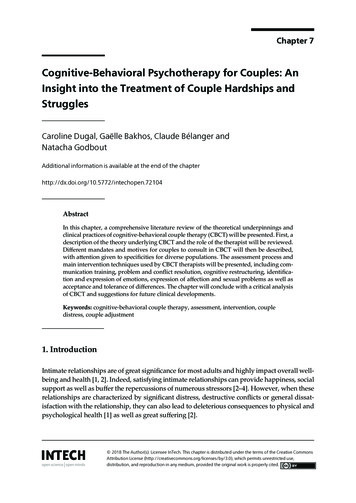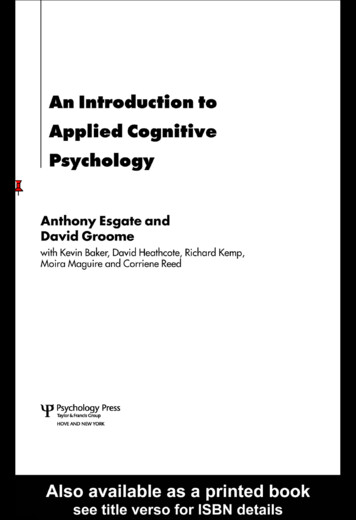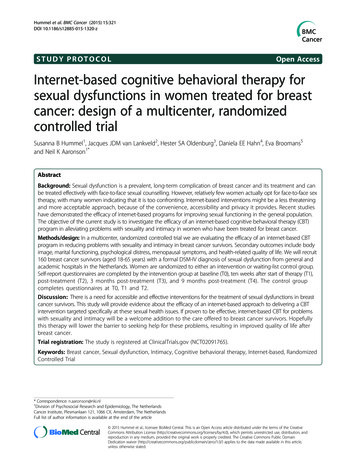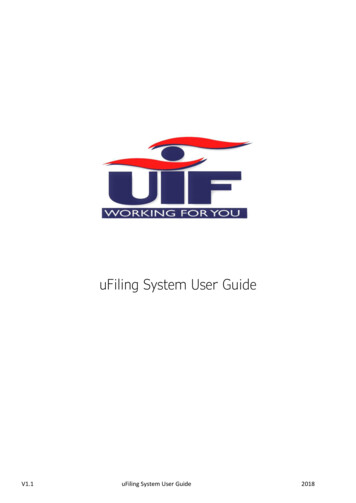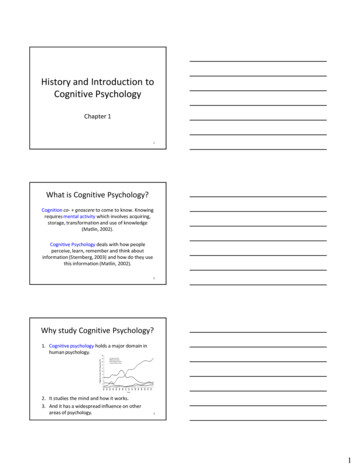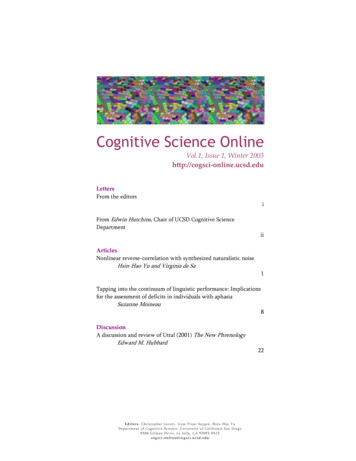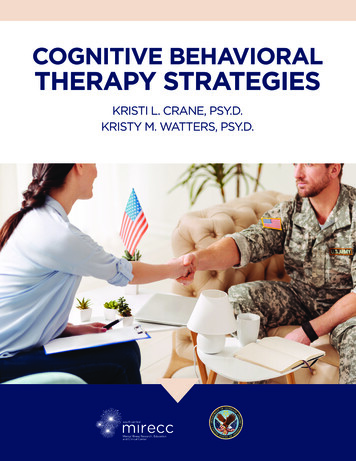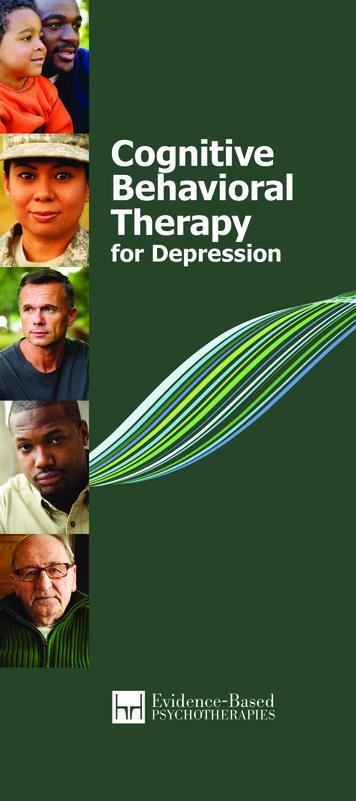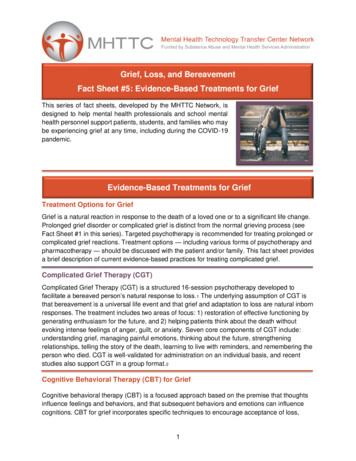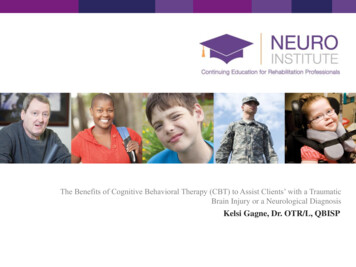
Transcription
The Benefits of Cognitive Behavioral Therapy (CBT) to Assist Clients’ with a TraumaticBrain Injury or a Neurological DiagnosisKelsi Gagne, Dr. OTR/L, QBISP
Professional Experience Fourteen years clinical experience in the occupational therapy profession ina variety of settings. Doctorate degree from Nova Southeastern University. Specialization:Gerontology, Health policy and Visual Rehabilitation/Low vision. Adjunct faculty member at the University of Southern Maine. Certified Brain Injury Specialist. Life Coach- certified in September, 2021. Speaker: Envision Conference x2 years and will be speaking at the BIAAconference in Maine. Published article in OT Practice Magazine with co-author Catherine Piercefrom Nova Southeastern.4
Course Objectives Describe the background and benefits of CognitiveBehavioral Therapy (CBT). Delineate the spectrum of emotions and namestrategies for emotional regulation and intelligence. Describe specific and easy to implement CBT andother mindfulness interventions.
Ice Breaker What are your thoughts regarding this presentation? What are your feelings on this presentation? How can you choose a thought that will best serveyou and give you the highest results?Footer6
Cognitive Behavioral Therapy (CBT) Cognitive Behavioral Therapy (CBT) was developed byAaron Beck (psychiatrist) and Judith Beck (psychologist). CBT is a form of psychological treatment that has beendemonstrated to be effective for a range of mental healthdiagnoses (American Psychological Association, 2017) The cognitive model hypothesizes that people’s emotionsand behaviors are influenced by their perceptions of events(Beck, 1964).CDC,20217
Cognitive Behavioral TherapyIn 1977, Dr. Beck and A. John Rush, MD completed arandomized control study of CBT with depressed clients.– The results established that cognitive therapy was aseffective as Imipramine, a common antidepressant.– This was the first time talk therapy had been comparedto medication.– In 1979, the first cognitive therapy treatment manualwas published.CDC, 20218
Cognitive Behavioral Therapy David Burns, M.D. was one of the first practitioners along sideof Beck to help develop and practice CBT. Burns would often collaborate with Aaron Beck about CBTand Burns went on to write a book called Feeling Good TheNew Mind Therapy a book for people to self-teach andpractice CBT independently in their daily lives.CDC, 20219
Cognitive Behavioral TherapyCBT is based on the fact that psychological problems are due to: Unhelpful ways of thinking or learned patterns ofunhelpful behavior How people feel is determined by the way in which theyinterpret situations rather than by the situationsthemselves.CDC, 202110
Cognitive Behavioral TherapyIndividuals experience thoughts continuously, whether or notthey are aware of them.These cognitions have been labeled as automatic thoughts,since they to occur spontaneously and without consciouseffort (Beck, 1976).CDC, 202111
Cognitive Behavioral TherapyIndividuals experience thoughts continuously, whether or notthey are aware of them.These cognitions have been labeled as automatic thoughts,since they to occur spontaneously and without consciouseffort (Beck, 1976).CDC, 202112
Cognitive Behavioral TherapyCBT believes people can learn and improve theirthoughts and thought patterns, as well as, theiremotional intelligence and coping skills, thereby,relieving their symptoms and become more effective intheir lives.( American Psychological Association, 2017)Footer13
Benefits of CBT Interventions Learn to recognize one's distortions in thinking thatcreate issues in their daily lives. Evaluate and change thoughts to a neutral, clear andrealistic thought. Work towards developing a sense of self-worth and agreater sense of confidence is one's own abilities.Footer14
Benefits of CBT Interventions Cont. Increase over-all emotional regulation and emotionalintelligence. Face one's problems and fears instead of avoidingthem. Practice mindfulness by learning to calm one's mindand relax one's body. (American PsychologicalAssociation, 2017)Footer15
Think-Feel-Act CycleFooter16
Beck’s Assessments Beck Youth Inventories of Emotional and SocialImpairment (BYI )– Second Edition (For children andadolescents ages 7-18) Beck Anxiety Inventory (BAI ) Beck Depression Inventory (BDI ) Beck Scale for Suicide Ideation (BSS ) Beck Hopelessness Scale (BHS ) Clark-Beck Obsessive-Compulsive Inventory (CBOCI ) BDI – Fast Screen for Medical PatientsObtain at: essionals/patient-assessment-tools/17
Emotional Regulation All emotions are needed and a part of the human experience(Beck, 2020). Negative emotions are a great sign that we need to be curiousabout our thoughts. Emotions are on a spectrum, therefore, none are Bad or Good. We all process emotions differently. Feelings are 50/50. We cannot just delete our emotions. Feelings are the emotional state of the mind which cannot beexplained but only experienced. They are an effect of themind- experienced in our bodies. An emotion is a vibration inyour body (Castillo, 2009)Footer18
Emotions/FeelingsRetrieved from: 3f6337b1b2a5652bfdeb88.jpg19
Measuring EmotionQuestions to help understand someone’s emotionalstate include: Where do you feel each emotion in yourbody? How long does the emotion last? Where are you on a Likert scale (0-10)? Notice any resistance to the feeling? What are easier emotions for you to feel? What are harder emotions for you to feel?Footer20
Emotional Buffering Emotional Buffering is simple numbing your emotions byconsuming versus feeling the emotion.– Smoking– Drinking– Shopping– Watching television for hours– Playing or scrolling on your phone– Over workingFooter21
Brain Break: Power of Our Thinking You can pretty much guarantee that you’ll spill yourcoffee if you keep telling yourself, “Don’t spill thecoffee!” Nine times out of ten, you’ll hit the telephone polethat you’re so intent and focused on avoiding whenyour car skids out of control.Footer22
CBT Intervention “All beliefs carry with them consequences.” -Tony RobbinsImage retrieved from: t-cycle-and-how-we-can-use-it-to-behappier/#: :text 20treat%20depression.23
Thought Work: The ModelThe model states that circumstances can triggerthoughts that cause feelings that cause action that that inturn cause results.1. Circumstance2. Thought3. Feeling4. Action5. Result(Castillo, 2009) Master Life CoachFooter24
The Model Cont.Why do thought work (CBT)?1. To feel better,2. To create results,3. To becomes conscious,4. To think more deliberately,5. To remove negative thinking and emotions,6. To create positive thinking and emotions.“Empowering thoughts” (Castillo, 2009, pg. 28)Footer25
The Model FrameworkC:T:F:A:R:*Can be filled out in any order but you usually start with thecircumstance.Footer26
Circumstances Circumstances: Things or events that happen in theworld that we cannot control. Needs to be judgment free Neutral Simple and clear fact Example: Circumstance: Performing Exercises in OTFooter27
Thought Download Take of a piece of paper and write everything that youare thinking in your mind right now. C: My current thoughts How do these thoughts make you feel?Footer28
ThoughtsThoughts: Ideas that happen in your mind. Do a thought download, then choose 1 thought. Challenge a thought in the moment. Not positive thinking but inserting a thought thatbetter serves you. Example: T: “My Left arm is junk completelyuseless.” What do you think these thoughts create for a feeling?Footer29
Thoughts Feelings: Vibrations that happen in your bodycaused by thoughts, not circumstances Be sure the thought your examining actuallycauses the feeling. Utilize a list of emotions if able. Where do you feel this emotion in yourbody?Footer30
Feelings Example: F: frustrated, disempowered, discouraged Powerful Questions:– How do I want to feel instead?– Do I like this feeling?– Is this truly the emotion I am feeling?Footer31
ActionsActions: Our behavior- what we do in the world. Actions are caused by feelings, determined bythoughtExample: Actions Ruminate on what you are lacking. “Why is my Leftarm junk?” Continue to judge your abilities.Footer32
Results Results: The end result. What did your thoughtscreate for you? What did you want for results? Example: Possible results for client Make zero changes or slow your capabilities tolearn and grow. Gain evidence that you are a failure or yourthoughts are correct. Therapist and Staff help you get curious aboutyour thinking!Footer33
Powerful QuestionBefore we go on Do you truly discuss yourclient’s thoughts, feelings, and results with themduring sessions? No right or wrong answer. Would this change their results?Footer34
Intentional ModelC: Performing Exercises in OTT: a.)These exercises are going to help me reach mygoal of being able to complete my laundryindependently.b.) I am capable of doing these exercises to the bestof my ability in order to get results. List all the functional things or strengths concerningthe Left side Use active listening skills in order to let client createthe new thought.Footer35
Intentional Model F: Content, Empowered, Motivated. A: Perform the exercises with improved effort, focus andengagement in the sessions.Footer36
Intentional Model Results: Create evidence for your brain that the Left arm isuseful and functional. Increased confidence and belief in capabilities. Client consistently participates in OT with moreengagement and motivation to accomplish theirgoals.Footer37
Burn’s Triple Colum ple-column-technique/- image retrieved38
Modifications Ideas for CBT Gallagher, McLeod, Mc Millan (2016) performed asystematic review of recommended modifications of CBTfor people with cognitive impairments following braininjury– Provides a framework for clinicians to apply andadjust CBT procedures Learned about the diverse nature of helping peoplerecover from emotional dysregulation andadaptation following brain injury. Progress in this field will be accelerated if thequality and clarity of specific therapy adaptations isimproved.Footer39
Modifications Ideas for CBT Gallagher, McLeod, Mc Millan (2016) performed asystematic review of recommended modifications of CBTfor people with cognitive impairments following braininjury– Provides a framework for clinicians to apply andadjust CBT procedures Learned about the diverse nature of helping peoplerecover from emotional dysregulation andadaptation following brain injury. Progress in this field will be accelerated if thequality and clarity of specific therapy adaptations isimproved.Footer40
Modifications Ideas for CBT Cont. Attention/Concentration:– Short Sessions– Add multiple rest breaks– Increase frequency of sessions Communication:– Use clear, structured, and simple statements anddirections– Use visuals or other multisensory modalitiesFooter41
Modifications Ideas for CBT Memory:– Use written or auditory memory recallstrategies– Involve family member or supports to ensurecarry-over of strategies Therapeutic Education– Modify based on cognitive assessment– Connect CBT with TBI educationFooter42
Modifications Ideas for CBT Cont. Executive Functioning– Go slow and allow for processing time– Use frontloading and structure to organize sessions– Use concrete examples– Promote flexible thinking- client comes up withalternative solutionsFooter43
Mindfulness Interventions Mindfulness is defined by the Oxford dictionary as a mental state achievedby focusing one's awareness on the present moment, while calmlyacknowledging and accepting one's feelings, thoughts, and bodilysensations, used as a therapeutic technique. It’s impossible to completely eliminate emotions because emotions are anormal part of life. Mindfulness is a strategy to help people develop a newrelationship to experiences such as anxiety, not to eliminate theseexperiences -cbt/, 2018).Footer44
Imagery Imagery can be defined as “Mental picturesand imagination” -Merriam-Webster Dictionary. Images in our head have the power to affect how wefeel positively or negatively (just like thoughts). Imagery is a form of meditation. Meditation allows us to engage in contemplationor reflection. Achieve a mentally clear andemotionally calm and stable stateFooter45
Imagery Focus on empowering imagery in order to increasepositive emotions and confidence. Recall memories or practice upcoming situationsthe client have coped or problem-solvedsuccessfully before the circumstance. Use all five senses. Great way to start or end sessions OR your day asa practitioner.Footer46
Imagery Example– Assess what your client sees in his or her mindthoughts about the mental pictures and the emotionsconnected. Do they want to change the pictures to achievedifferent emotions? Can they see themselves achieving their goals?– Imagery allows you to go to a private place whereanything is possible.– Relax your body and your muscles Take 3-5 minutes to do this mentally at the start orend of each formal session. Lying on a mat or in acomfortable position.Footer47
What Do Our Bodies Need To Survive? WaterOxygenFoodMaybe Shelter. Important to educate our client’s on their basic needs and helpthem engage in self-care during the day. Mindful: What does my mind and body need in this moment?Footer48
Deep Breathing“Improper breathing is a common cause of ill health. If I had tolimit my advice on healthier living to just one tip, it would besimply to learn how to breathe correctly. There is no single morepowerful, daily practice to further your health and well being thanbreath work.”-Andrew Weil, M.D. Author of Spontaneous HealingFooter49
Deep Breathing Oxygen fuels our cells and helps provide the basic buildingblocks that our bodies need to survive (Cancaster, 2021) Oxygen is necessary for constructing replacement cells for ourbodies. Every day, about seven hundred billion cells in ourbodies wear out and must be replaced. Without oxygen, newcells cannot be made. Oxygen is important part of our immune system. It is used tohelp kill bacteria, and it fuels the cells that make up our body'sdefenses against viruses. (Cancaster, 2021)Footer50
Deep Breathing Wim Hoff: https://youtu.be/tybOi4hjZFQ– Wim Hof Method: a combination of breathing, coldtherapy and commitment that offers a range of benefits.(See https://www.wimhofmethod.com) Pursed Lip Breathing:– In through your nose (short inhales) and out through yourmouth (long exhales- 4-5 seconds) Diaphragmatic Breathing: by an OT– https://www.wimhofmethod.com/Footer51
Relaxation and Self-Soothing MassageGetting outdoorsJoin social or support groupsPlace your hand over your heart and repeat an affirmationPractice gratitude Make daily list of 3 things in a.m. or p.m.Footer52
Relaxation and Self-Soothing Use self-soothing tools such as a weighted blanketPet therapyMusic and dancingTaking a hot bath or showerAromatherapy and the use of essential oilsDrink a hot glass of herbal teaFooter53
Questions?Footer54
References Aron, E. N. (1996). The Highy Sensitive Person: How to Thrive When the World Overwhelms You.New York: Broadway Book. Beck, J. S. (1964). Cognitive Therapy: Basics and Beyond. New York: Guildford Press Burns, D. (1981). Feeling Good: The New Mood Therapy. New York, N.Y: Penguin Books Cancaster, B. (2021). Why Your Body Needs Oxygen. Retrieved ygenCastillo, Brooke (2008). Self Coaching 101: Use Your Mind- Don’t Let It Use You. FuturesUnlimited Coaching. ISBN 0977853993 Dweck, C. (2007). Mindset: The New Psychology of Success. Ballantine Books. ISBN 0345472322 Gallagher, M., McLeod, H.J., & McMillan, T.M. (2016). A Systematic Review ofRecommendedModifications of CBT for People with Cognitive Impairments Following Brain Injury.Neuropsychological Rehabilitation, DOI:10.1080/09602011.2016.1258367 Margolies, L. (2016). Are Your Decisions from your Evolved or Primitive Brain? Retrieved ain2#155
References Lew, H.L., Oh-Park, M., Cifu, D.X. The war on COVID-19 pandemic: Role of rehabilitationprofessionals and hospitals. Amer J Phys Med and Rehab Articles Ahead of Print.DOI:10.1097/PHM0000000000001460Khan, F., Amatya, B. Medical rehabilitation in pandemics: towards a new perspective. JRehabil Med (2020); 20:jrm00043Salawu, A., Green, A., Crooks, M.G., Brixey, N., Ross, D.H., Sivan, M.J. A proposal formulti-disciplinary tele-rehabilitation in the assessment and rehabilitation of covid-19survivors. Int J of Env Res and Pub Health (2020) 17, 4890.Biehl, M., Sese, D. Post-intensive care syndrome and COVID-19-implications postpandemic. Cleveland Clinic Journal of Medicine (2020) August, DOI:https://doi.org/10.3949/ccjm.87a.ccc055Halpin, S.J., McIvor, C., Whyatt, G., Adams, A., Harvey, O., McLean, L., Walshaw, C.,Kemp, S., Corrado, J., Singh, R., Collins, T., O’Connor, R.J., Sivan, M. Postdischargesymptoms and rehabilitation needs in survivors of COVID-19 infection: A cross sectionalevalutation. J Med Virol. 2021;93:1013-1022.Bowles, K., McDonald, M., et.al. Surviving COVID-19 after hospital discharge: symptom,functional, and adverse outcomes of home health recipients. Ann Int Med (2020 ) 24November. https://doi.org/10.7326/M20-520656
Aug 27, 2021 · Cognitive Behavioral Therapy David Burns, M.D. was one of the first practitioners along side of Beck to help develop and practice CBT. Burns would often collaborate with Aaron Beck about CBT and Burns went on to write a book called Feeling Good The New Mind The


